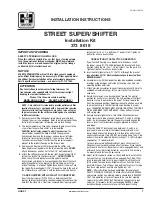
STARTING AND OPERATING
225
before and after the shift. If after a few rock
cycles your vehicle is not free, stop and try
another method of recovery. Continuous rock
cycling will only cause unnecessary damage
to your vehicle and the environment.
Using The Tow Hooks With A Tow Strap – Tow
straps are a quick and easy way to recover
your vehicle from minor situations if you have
a secondary vehicle which is not stuck. The
tow hooks on your vehicle are designed to
take the abusive force generated during
vehicle recovery. Do not use the bumper or
any other vehicle component as an attach
-
ment point. Using tow straps requires coordi
-
nation between the two drivers. Good
communication and line of sight are required
for a safe recovery. First connect the tow
strap to the correct attachment points on
both vehicles. There should be a least 20 to
30 feet (6 to 9 meters) between the vehicles
to allow for a safe recovery. If necessary join
two tow straps together using a 1 ½ inch
hard wood dowel. This will keep the straps
from becoming knotted and is safer than
using a clevis pin if the strap breaks. Next
have the tow vehicle backup, leaving two to
three feet worth of slack in the strap. Then
the tow vehicle, using light throttle, should
accelerate tightening the strap providing the
pulling force needed to free the vehicle. The
vehicle being recovered should assist in the
recovery, at the time of the snap, by slowly
spinning the tires in the same direction as
the pulling vehicle. After the vehicle becomes
free, the driver of the previously stuck vehicle
should signal they are free and should hit
their brakes stopping both vehicles. The
driver of the pulling vehicle should let off the
throttle without using the brakes, once
signaled by the other driver. This sequence is
important to avoid having the recovered
vehicle hit the pulling vehicle.
Winching (Refer To “Winch Operation” For
Additional Information) – Winching is most
commonly used in the following situations:
there is no support vehicle available, a high
controlled force is required to recover the
vehicle, there is a high risk of environmental
or vehicle damage, or where nothing else
seems to work. A winch can deliver a high
pulling force with a great deal of control. It
allows you to walk the vehicle out of the situ
-
ation in a slow controlled manner. This
control works well for avoiding further vehicle
damage. Once you decide it is time to use the
winch look for a good anchor point. It needs
to be strong enough to hold more than the
CAUTION!
Damage can occur when spinning your tires
at an excessive high speed. Do not spin your
tires faster than an indicated 30 mph
(48 km/h).
WARNING!
Never use tow straps with end hooks or link
two straps with a clevis pin. These heavy
metal objects could become projectiles if a
strap breaks, which could cause severe
injury. Never leave more than 2 to 3 feet (.6 to
1 meter) of slack in the strap. More slack
than this greatly increases the risk of injury
and vehicle damage. Always keep everyone at
least 30 feet (9 meters) away from a
strapping or winching situation.
5
19_DJD2_OM_EN_USC_t.book Page 225
















































